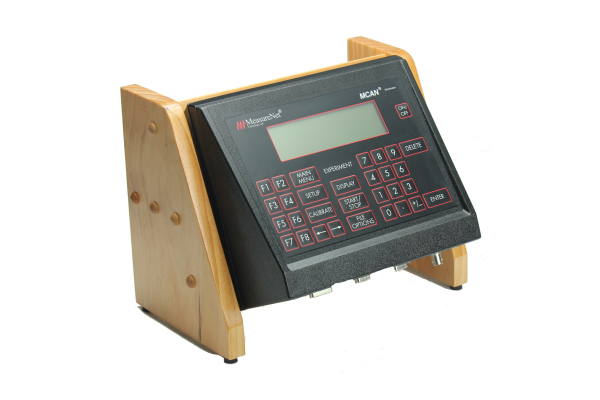
The modernization of a universities General Chemistry laboratory program can be a daunting and yet necessary task. This is especially true when you have 2000+ students taking General Chemistry every year. The University of Tennessee, Knoxville decided it was time to modernize their General Chemistry Lab Program for them to remain competitive. They knew that Electronic Data Collection Technology needed part of this process, and needed to be integrated into the labs. I am happy to say The University of Tennessee, Knoxville decided MeasureNet's Electronic Data Collection System was the technology selected in the redesign of their General Chemistry Laboratory Program.
“The laboratory makeover not only benefits the first-year students, but will help improve their preparation and success as they go on to take upper-level chemistry courses, “
Al Hazari, Director of Undergraduate Laboratories.
%20Systems-resized-601.png)
Department of Chemistry and Biochemistry, Miami University, Oxford, Ohio 45056, United States
J. Chem. Educ., 2013, 90 (4), pp 500–505
DOI: 10.1021/ed300340x
Publication Date (Web): March 15, 2013
Copyright © 2013 The American Chemical Society and Division of Chemical Education, Inc.
Abstract
The large class sizes of first-year chemistry labs makes it challenging to provide students with hands-on access to instrumentation because the number of students typically far exceeds the number of research-grade instruments available to collect data. Multifunctional chemical analysis (MCA) systems provide a viable alternative for large-scale instruction while supporting a hands-on approach to more advanced instrumentation. This study describes how the capabilities of MCA systems are extended to introduce liquid chromatography (LC) and flow injection analysis (FIA) in undergraduate laboratories. A semi-micro plastic cuvette with a Teflon tubing insert is fashioned as the flow cell for a MCA absorbance–fluorescence detector. Two MCA systems, Vernier and MeasureNet, are used in two unique experiments demonstrating the detection of salicylate in aspirin tablets by FIA and the LC separation of a mixture of riboflavin and fluorescein. Both instruments, composed of a syringe pump, T-injection valve, and the MCA detector, operated in the kinetic mode, are rugged and inexpensive permitting student construction, if desired.
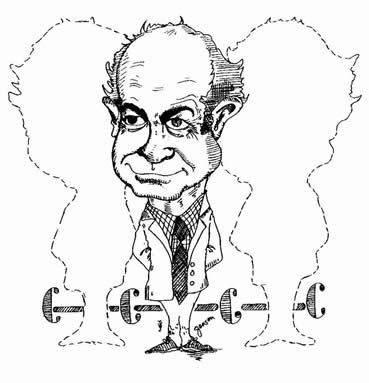
Linus Pauling (1901-1994). American chemist. Professor at the California Institute of Technology (1927-1962), and Nobel Prize winner for both chemistry (1954) and peace (1962). Though Pauling began his career as a crystallographer, he is best known for his work on the electronic theory of the chemical bond, as summarized in his 1939 monograph, The Nature of the Chemical Bond, and for his later work on the molecular and electronic structures of large biomolecules. His name is most often associated with his scale of ionic radii (1927), his rules for rationalizing the most stable structures for complex ionic crystals (1929), his extensive use of the both the hybridization (1931) and resonance concepts (1932) in chemical bonding, and his thermochemical electronegativity scale (1932). He also gained considerable notoriety for his political activism in support of nuclear disarmament, and for his controversial advocacy of the supposed medical benefits of megadoses of vitamin C.
Courtesy of Professor William Jensen, Oesper Chair of the History of Chemistry and Chemical Education, University of Cincinnati

According to the American Chemical Society, hands-on activities significantly enhance learning at all levels of science education. The American Chemical Society, or ACS, is the world’s largest association of individual chemical scientists and engineers, and its newest science education policies communicate the importance of hands-on learning in the science lab. ACS education programs begin pre-kindergarten and extend through undergraduate and graduate studies.
Hands-on activities are the basis for the laboratory portion of any science class and are essential for learning chemistry. A student enrolled in a hands-on chemistry course directly experiences laboratory chemicals, chemical properties and reactions as well as gaining familiarity with laboratory equipment and apparatus. There is simply no substitute for the real-life experience of hands-on training.
One good example demonstrating the superiority of hands-on learning over simulation or lecture is teaching a child to ride a bicycle. Putting a child on a bike and giving her a push teaches her much more in one minute than she could gain by watching videos of other children on bicycles or listening to a lecture on physics. Hands-on learning allows for deeper comprehension of scientific principles, and it benefits the American Chemical Society and the rest of the United States to campaign for a return to this inclusive style of education.
ACS has good reason to promote hands-on learning. A 1982 meta-analysis of 15 years of research including 57 studies of 13,000 students showed that students who participated in hands-on education scored 20 percent better than did students using traditional or textbook approaches. The students engaged in hands-on learning demonstrated gains in creativity, attitude, perception and logic. The National Assessment of Educational Progress noted that teachers who incorporated hands-on activities into the curriculum at least once a week out-performed their peers by more than 40 percent of a grade level in science.
No Child Left Behind act, or NCLB, appears to have had an unintended negative impact on hands-on learning, particularly for children at the elementary and middle school ages. Science is not a federally mandated assessment, so teachers and administrators instead focused on subjects compliant with NCLB assessments such as reading and math. Pupils who were students during the height of NCLB continue to struggle with this deficit well into their post-secondary education unless given an opportunity to catch up with adequate hands-on training in the laboratory. For many, this chance does not occur until high school or beyond, if at all.
Undergraduate and graduate institutions must offer hands-on opportunities in the laboratory to ensure graduates are able to meet and overcome the challenges of modern chemistry. Some of these advanced students will rely on these skills to solve real-world problems in the workplace while others return to the classroom to teach others. ACS challenges teachers to reach new goals of excellence and advocates certain measures to help educators achieve superiority, including requiring teachers to take undergraduate courses to ensure they are prepared to teach coursework and enhancing funding at all levels so that science teachers have access programs that allow them to expand and update their science knowledge base. ACS also encourages teachers and school systems to use technology to reach students with different learning styles. The ACS is also dedicated to improving the work conditions of science teachers, reduce attrition and improve safety in the classroom laboratory.
Some educators are tempted to take advantage of the shortcuts modern technology has to offer but teachers should choose wisely. Computer simulations are flashy and inexpensive but are not an adequate substitution for hands-on activities, even at the collegiate level. Educators must use computer simulation as a supplement to, not as a replacement for, hands-on learning. While intellectual curiosity should be piqued with internet searches, guided by lectures and accelerated with computer simulation and video, hands-on learning is still one of the most effective ways to instill confidence in knowledge and increased comfort with using laboratory and technical equipment.
ACS recognizes the special need for new assessment equipment at the undergraduate level. This equipment should assess a student’s understanding of science and the use of methods of science to give the instructor a fuller appreciation of the student’s grasp of science, not just his ability to recite scientific facts. Giving students access to a shared diode-array visible or UV-vis spectrometer to perform absorption, emission, fluorescence and reflectance experiments has so much more impact than just describing.
The American Chemical Society emphasizes the importance of a hands-on, inquiry-based approach to science to not only help students gain knowledge and understanding of scientific principles but also to teach students how scientists explore and make sense of the natural world. Hands-on learning teaches students to learn with the same tools used by professional scientists. It teaches them to think like scientists by creating hypotheses, making observations and performing inquiries. Students improve skill proficiency in scientific processes, such as laboratory work, graphing results and interpreting data.
Hands-on learning has been around since the days of Aristotle, who said, “What we have to learn to do, we learn by doing.” Hands-on learning enhances the student’s ability to test, sense, apply and learn. This type of learning involves and improves upon the art of questioning. Use hands-on, state of the art analytical instrumentation to revolutionize the way your students learn chemistry and science in your classroom laboratory.
“I hear and I forget, I see and I remember. I do and I understand”
Chinese proverb
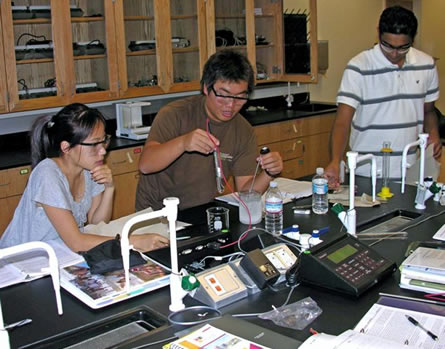
“Why do I have to learn junk I’ll never use in real life?” is arguably the most harrowing question to ever echo in a science or math classroom. For generations, an education in science, engineering or math has been mostly reserved for only those very bright students intending to pursue an advanced degree in one of those disciplines. Most of these students were white males, with strong social stigmas preventing females or students in minority groups from participating. Students who wanted to work in other professions or stay at home to raise kids often avoided science and math classes, thinking a working knowledge of these subjects unnecessary for a workaday life. Today’s fierce global economic climate does not allow modern student to cherry-pick skills to take into the workplace – even the most rudimentary jobs require a certain amount of technical sophistication and understanding of STEM subjects. While most students will not eventually work in a STEM field, they will enjoy life-long benefits from their experiences studying in a STEM-rich environment.
National Economy
A workforce well-educated in science, technology, engineering and math, or STEM, skills is now an absolute necessity to keep the United States in a competitive position in today’s global economy. According to a 2009 assessment of 15-year olds, the United States pulled a below-average ranking of 32nd in mathematics and an average rank of 23rd in science. These dismal statistics worry economists, industry leaders and politicians who recognize the power innovations science and technology has on the nation’s positions in the global markets. Knowledge is the engine that drives that innovation. Our nation needs an innovative strategy to its technical strength enough to compete in today’s global economy.
Improved Learning
One of the most obvious and innovative national strategies is to put STEM technology directly into the hands of high school students. STEM education transforms a teacher-centric classroom into a laboratory where curiosity and innovation propel discovery and learning. Cutting-edge STEM education tools replace dusty static textbooks with real-life technology. Lectures and memorization are swapped with curiosity and discovery, a more natural and long-lasting form of learning. The faces of students in an interactive STEM laboratory setting brighten as natural curiosity and inquisitiveness reawaken and reinvigorate their imaginations. The student shakes off her role as a passive learner and jumps right into the business of innovative thinking and learning. This type of exploratory thinking encourages valuable problem-solving and discovery skills students can use later in life, whether they plan to further their STEM education, go directly into the workforce or even stay at home and raise children.
Critical Thinking
Classes in STEM studies enhance critical thinking skills and require students to actively engage in a situation in order to find the solution. Students develop the same problem-solving skills in the secondary and post-secondary classroom as they will eventually use in the workplace. A savvy educator puts current technology into these students’ hands so they grow comfortable using these tools. Youngsters build STEM-specific proficiency along with critical thinking skills and familiarity with equipment as they go through secondary and post-secondary school or directly into the job market.
Increase Interest in STEM
Education in STEM studies during high school promotes interest in pursuing a post-secondary STEM degree. In a recent survey, four out of five STEM college students say they decided to study STEM while still in high school; more than half say that a specific class or a teacher, rather than a family member, got them interested in STEM subjects. This is especially true for women, with 68 percent of female students citing a teacher or a class as being the main motivation behind their decision to study STEM. Unfortunately, only one in five college STEM students say that elementary and high school adequately prepared them for college STEM courses. These students said it would have been helpful to take more STEM courses and for these courses to be more challenging.
Improved Collegiate Performance
The universities teaching advanced STEM courses would agree. One of the largest problems post-secondary institutions face is under-prepared freshmen. Universities and colleges yearn for entrants who are better educated in STEM subjects. Students entering STEM studies are woefully underprepared for collegiate courses and many students drop out before earning a degree.
Better Pay
Post-secondary STEM education results in better pay, even for workers who wind up in non-STEM positions. A person with a STEM degree will earn 13 percent more for the same job as another person without such credentials. This is especially true for women and minorities in STEM fields. While there is a gender and race gap associated with most other professions, women in STEM jobs make almost as much as their male counterparts.
The STEM skills learned in high school will serve a student well, even if she does not pursue a college degree or work in a STEM field. Even jobs in a big box store or fast food chain requires the use of hand-held electronic devices or scanners. Only repetitive, manual labor tasks do not require at least a fundamental education and the need for workers to perform this type of work has declined rapidly since the 1960s. Technology and robotics have replaced these workers with industrial machines. Today’s employers require interactive workers able to perform non-routine tasks based on a sound decision-making.
A secondary education rich in STEM studies benefits all students, whether they intend to pursue an advanced degree in the sciences or just work at the local discount store. STEM studies help students develop critical thinking skills, familiarize future workers with the equipment they will someday use and spark an interest in STEM fields. Improving secondary STEM education will improve our national workforce and enhance the way American workers do business.Discover all the learning solutions you can incorporate into your STEM laboratory.
Sparking a student’s interest in science, technology, engineering or math can launch her on a new career in the highly-lucrative and rapidly-expanding opportunities in STEM fields. Great pay, interesting work, job security and good working conditions are the norm for those holding a STEM degree or working in a STEM field, such as computer and information technology, engineering or life science. STEM fields are closing the gender gap, encouraging more women to reap the benefits of an education in science and technology. Solid STEM training benefits the workers of today and tomorrow.
Good Pay
Whether you earned a degree in a STEM field or you work in a STEM field without holding a diploma, STEM increases your average wages. A STEM worker with a bachelor’s degree will earn on average $7 more per hour than another person with the same credentials in a non-STEM occupation. Just holding a degree in a STEM field will increase wages. A person with a STEM degree makes 13 percent more doing the same job as a person without such an education. Those who study STEM or gain a degree in a STEM field have higher wages, even if they don’t ultimately work in a STEM field.
To put it in hard numbers, the Bureau of Labor Statistics, or BLS, reports the average annual wage for all STEM occupations was $77,880 in May of 2009. Natural science managers were the highest paid STEM workers, followed by engineering and computer science managers. These highest-paid workers held mean wages in excess of $100,000 or more.
Interesting Work
Working in a STEM job is exciting. All the cool things we love today are the result of the innovating and creative thinking of countless STEM workers, including our phones, computers and video games, live-saving medicines and other technical miracles. Whether a STEM worker uses her skills to bring a rare species of animal back from the brink of extinction or to design the automobile of tomorrow, work in a STEM field will always be challenging and highly rewarding.
Lower Unemployment
Workers in STEM jobs face a lower risk for unemployment than laborers in other fields. In 2010, unemployment rates among non-STEM workers were almost 10 percent, compared to only 5.3 percent unemployment among STEM workers. It is possible that this lower unemployment rate is due to the higher level of education among STEM workers; solid education, especially in STEM fields, reduces unemployment.
Increased Opportunities
The topic of STEM jobs and the education to get those lucrative jobs has never been hotter. The BLS projects STEM job growth to have grown 22 percent between the years of 2004 and 2014. Computer specialist occupations are expected to have grown much faster than average. Despite a sluggish national and global economy, STEM jobs continue to enjoy expanding opportunities for well-educated workers.
Decreased Gender Gap
There is a smaller economic gender gap in STEM jobs than in other professions, with women earning nearly the same income as men for performing a STEM job. Women who work in STEM fields make on average 33 percent more than women who work in non-STEM jobs. Many women with a STEM degree work in education or healthcare rather than in a STEM field.
Good Working Conditions
STEM jobs are usually performed inside air-conditioned offices or laboratories in technical parks located in nice sections of the country, such as southern California or Boulder, Colorado. Most of these jobs are quite safe, extremely exciting and always challenging. STEM workers typically share clean, quiet environments with other well-educated, like-minded professionals.
Before a worker enters the profitable and rewarding STEM field, he needs a solid STEM education. Early and secondary education is the key, whether a student plans to study STEM or enter a STEM field directly out of high school. Introducing students to science, technology, engineering and math at an early age can foster a passion that puts future workers on the right path, rich in financial and professional rewards.
http://educationupdate.com/archives/2011/NOV/HTML/col-stemjobs.html
http://www.bls.gov/opub/ooq/2007/spring/art04.pdf
http://www.bls.gov/opub/mlr/2011/05/art1full.pdf
http://www.esa.doc.gov/sites/default/files/reports/documents/womeninstemagaptoinnovation8311.pdf
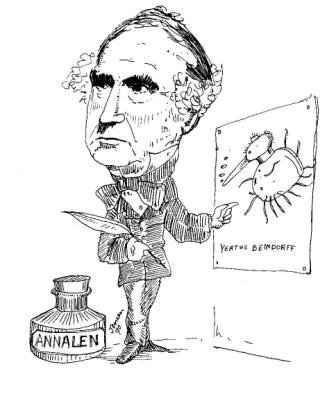
"Annalen"
Justus von Liebig (1803-1873) Professor at Giessen (1824-1852) and Munich (1852-1873), Liebig's teaching laboratory at Giessen served as the model for the advanced training of chemists in the first half of the 19th century, including many foreign students from Great Britain and the United States, and, through his editorship (starting in 1832) of the journal, Annalen der Chemie und der Pharmacie (which is still published under the name of Liebig's Annalen), he exercised enormous influence on the early development of organic chemistry, agricultural chemistry, and physiology. He perfected organic combustion analysis (1837) and the counter-current laboratory condenser (1843), and, in collaboration with his close friend, Friedrich Wöhler, did pioneering work on the isomerism of fulminates (1823-1826) and the reactivity of the benzoyl radical (1832).
Courtesy of Professor William Jensen, Oesper Chair of the History of Chemistry and Chemical Education, University of Cincinnati
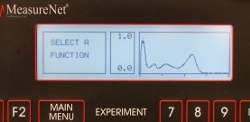
Science and technology bond together like carbon and hydrogen. One field benefits the other- scientific discoveries advance technological applications which then return more sophisticated research tools to the scientific community. Many of your chemistry students will graduate into a world that integrates science and technology into a singular platform that utilizes electronic data collection technology, a safer and more efficient mode of gathering and managing information. Give your freshman chemistry students the technological edge they need to facilitate learning while simultaneously freeing yourself from expensive hardware upgrades, viruses and archaic forms of monitoring student progress in your freshman chemistry lab.
When you switch to electronic data collection technology, you’ll immediately notice how much more available space you have in your general chemistry lab. In the typical, old-fashioned general chemistry lab, each student shared bench space with their own large, cumbersome PC. These PCs are at increased risk for virus infection, costly hardware and software upgrades and usually need to be replaced every three to four years. The MeasureNet MCAN, or Multifunctional Chemical Analysis Network, replaces up to 15 individual PCs with a single PC that is used by the instructor to monitor student activity and manage their data files, locally or on the cloud.
Student workstations integrate with a wide variety of probes and other chemistry laboratory apparatus that enable your chemistry lab students to accurately perform hands-on experiments in general chemistry, environmental chemistry, STEM and biochemistry labs. These hands-on lab exercises are critical for the students’ development of basic chemistry concepts.
Chances are good that students in your general chemistry lab are already technologically advanced and have used electronic data collection technology in high school. They are also quite accustomed to cloud computing from using products like Google Docs and Dropbox, where both software and files are saved online rather than on a personal computer. MeasureNet’s MCAN technology merges electronic data collection and cloud computing capabilities together. MCAN allows your student to measure and collect high resolution data in the lab and store it on the cloud for later analysis and lab report generation. Students, especially science students, will be excited to use the advanced technology MeasureNet MCAN offers. MeasureNet MCAN technology takes your students to the next level, giving your students the edge they need when whether they go on to industry or pursue advanced degrees in science.
Cloud computing also helps you monitor your chemistry lab students from the instructors PC to be sure they are conducting the experiment, collecting data and analyzing information properly. You can also monitor live data collection experiments remotely. Using the internet you can connect to MeasureNet MCAN workstations from outside the chemistry lab using a computer, tablet or smart phone.
MCAN electronic data collection technology can easily be in integrated into your current chemistry lab curriculum and can be adapted to fit a variety of teaching styles.
- POGIL
- STEM
- Self Directed
- Verification-style
- Inquiry-based Chemistry Labs
- Hands-on learning
You can easily integrate MeasureNet based experiments into your current lab curriculum. Here is a small sample of experiments that can be conducted with the MCAN technology.
- Gas Laws
- Colligative Properties
- Enthalpy of Reaction — Hess's Law
- Determination of the Heat of Neutralization of a Variety of Strong Acids and Bases
- Chemical Kinetics
- Determination of a Reaction Equalibrium Constant Using Absorption Spectroscopy
- pH and Buffer Solutions
- pH titrations and end-point determination using Drop Counter
- Identifying a Weak Unknown Acid
- Determination of the Molecular Weight of a Volatile Liquid Using the Ideal Gas Law
- Vapor Pressure and Heat of Vaporization
Using MeasureNet’s MCAN technology in your lab means you’ll spend less time working as a computer repair technician and more time teaching chemistry. The MeasureNet MCAN frees you from problems usually associated with PC-based systems. Virus removal and reimaging computers will be a thing of the past.
Get back to doing what you love – teaching chemistry to hungry minds – by replacing your old, worn out computers with intuitive space saving MCAN electronic data collection technology. Excite students in your general chemistry labs by using the same technically advanced instrumentation used by university research labs and real-world industry chemistry labs. Make your chemistry lab program exciting and technologically relevant to students by using electronic data collection technology in your labs.

"Gas"
Joseph Priestley (1733-1804). British chemist and Unitarian Minister. Priestley earned his living as a minister and teacher at various dissenting academies. His work in chemistry was done in his spare time and largely during the period when he served as private librarian to Lord Shelburne. It dealt almost exclusively with the use of the pneumatic trough to discover a large number of new "airs" or gases, including nitrogen oxide, nitrogen dioxide, dinitrogen oxide, ammonia, hydrogen chloride, sulfur dioxide and, most famously of all, oxygen (1774). He also investigated the processes of brewing, photosynthesis, respiration, and invented soda water. Priestley was a prolific writer, not only on chemistry, but also on the subjects of theology, history, geography, natural philosophy, and electricity. Due to
his liberal political opinions, his home and laboratory were destroyed by a Birmingham mob in 1791, and he spent his final years in Northumberland Pennsylvania, where he wrote several pamphlets defending the outdated phlogiston theory against Lavoisier's newer oxygen theory of combustion.
Courtesy of Professor William Jensen, Oesper Chair of the History of Chemistry and Chemical Education, University of Cincinnati
The Princeton Section of the American Chemical Society will be holding their annual National Chemistry Week Activities Night On Friday evening, October 21 from 7-9 pm. It will be held at Princeton University, Frick Laboratory, located on Washington Road, Princeton NJ. This year's theme is "Chemistry - Our Health, Our Future!
A week of fun and educational activities are planned in
Manhattan to showcase how chemistry makes life better. The events are part of National Chemistry Week, Oct. 16-22, and are sponsored by Kansas State University's local section of the American Chemical Society and the department of chemistry.
We will celebrate IYC 2011 at our yearly NCW Event held at the NY Hall of Science on Sat., 10/22! Local universities and companies will have a variety of cool hands-on demos for kids ages 5-15! We will also host a "Chemistry Bingo" where winners will win an IYC 2011 lapel pin and other neat goodies!
Enjoy classic chemistry experiments and learn the positive impacts of chemistry as it relates to nutrition, hygiene, and medicine.
10:00 - Chemistry activities, Protozone - Level 1
11:30 - Chemistry activities, Protozone - Level 1
1:00 - Cool Chemistry Program, Demonstration Station - Level 1
The No. Jersey Section's NCW celebration and student poster session will take place at a
ChemExpo celebration at Liberty Science Center on
Saturday, October 22 from 10:00 AM to 2:00 PM.
Saturday, Oct 22 10:00a to 1:00p
The Santa Clara Valley section of the American Chemical Society will hold a National Chemistry Week Celebration for kids of all ages. The Wheel of Chemistry Fortune will be spinning for all kids to win a prize, and there will be fun hands-on chemistry including a slime lab! This will also be an opportunity to pick up a free copy of “Celebrating Chemistry”, the NCW newsletter for elementary-aged children.
The New York Section of the American Chemical Society will be celebrating National Chemistry Week on October 22, 2011 at the Great Hall in the New York Hall of Science. This day-long event will showcase chemistry principles using demonstrations performed by local college students and volunteers from local industries for children of all ages. This year's theme is "Behind the Scenes with Chemistry" and the event will run from 11 am to 4 pm.
As part of the National Chemistry Week 2011 celebration, the International Year of Chemistry (IYC) and in recognition of its theme, "Chemistry - Our Health, Our Future!" The American Chemical Society (ACS) and the Department of Chemistry at Texas A&M University are sponsoring an illustrated poem contest for students living in the Brazos, Robertson, Burleson, Washington, Grimes, Madison, and Lean Counties in grades K-12.
National Chemistry Week, sponsored by the American Chemical Society, is celebrated at Gordon College by our department. See some of the different ways students and faculty get involved.